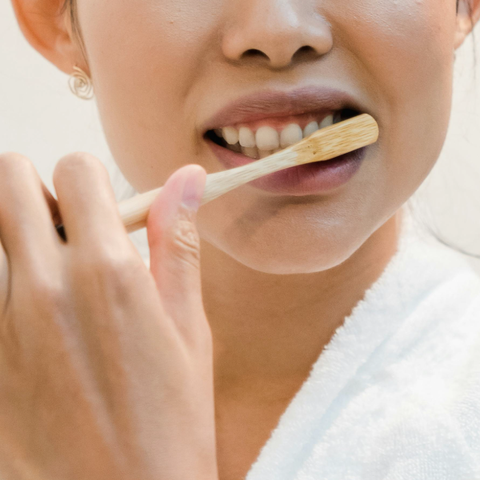
How to choose toothpaste that’s right for you
It's essential to take care of your oral health and choosing the right toothpaste is a key component in what should be your daily brushing routine. With so many formulas available, it’s no wonder people find themselves wondering if they should use a fluoride toothpaste or a fluoride free toothpaste. In this article, we’ll explore the pros and cons of both options to help you make an informed decision.
What is fluoride? Why is it used in dental care?
Fluoride is a mineral that is naturally found in water, air, soil and certain foods. It has numerous uses, including fluoridating drinking water, preserving wood, manufacturing glass and cleaning products and, of course, dental hygiene.
Studies have proven fluoride’s ability to prevent and fight cavities,[1] which is why dentists encourage its use.
Fluoride’s many advantages include:
- Strengthening tooth enamel. Fluoride helps enamel’s remineralization process (enamel being the tooth’s protective layer). Robust enamel is more resistant to erosion that can be the result of acidity, and wear and tear.
- Fighting dental plaque. Fluoride inhibits the growth of bacteria that is responsible for dental plaque, thereby reducing the risk of cavities.
- Remineralization. Fluoride penetrates tooth enamel and regenerates weak areas; This helps to slow enamel deterioration and repair areas that have started to weaken, putting a stop to cavity progression.
Fluoride toothpaste does in fact make a difference by having a positive impact on dental health. However, some people prefer, for a variety of reasons, to use fluoride free toothpastes.
Fluoride toothpaste or fluoride free toothpaste: Key points
It must be obvious by now: The main difference between fluoride toothpaste and fluoride free toothpaste is… the presence (or lack thereof) of fluoride. Fluoride toothpaste’s effectiveness rests upon the proven ability of the naturally derived ingredient of fluoride to prevent cavities and strengthen tooth enamel. Fluoride free toothpastes rely instead on other ingredients like baking soda and green tea extract that have cleaning, whitening and refreshing properties.
Here’s a summary of the pros and cons of each option:
Fluoride toothpaste
Pros:
- Effectiveness in preventing cavities. Numerous scientific studies confirm fluoride’s effectiveness in preventing and combating cavities.
- Enamel remineralization. Fluoride helps to repair areas of enamel that have been demineralized.
- Recommended by the Canadian Dental Association (CDA) and the World Health Organization (WHO). The CDA recommends prudent use of fluoride in preventive care and daily care products to prevent tooth decay.
Cons:
- Slight risk of dental fluorosis. According to Health Canada, dental fluorosis manifests as white spots on adult tooth enamel. It occurs when very large amounts of fluoride are ingested during early childhood while permanent teeth are developing under the gums. Dental fluorosis can be avoided by following the recommended toothpaste dosage instructions and consulting with a dentist for advice for children who are under three years of age.
Fluoride free toothpaste
Pros:
- Appropriate for people who are fluoride-sensitive. Some people may experience mild gum irritation when using fluoride toothpaste. Fluoride-free toothpaste may be a good alternative.
-
Personal preference. Some people may simply prefer to avoid fluoride in oral care routines.
Cons:
- Less effective protection against cavities. Although some ingredients in fluoride free toothpaste may contain cleaning properties, these do not offer the same level of protection against cavities as fluoride toothpastes.
- Inability to repair enamel. Fluoride-free toothpastes can’t remineralize dental enamel.
“How do I choose the right toothpaste?”
Choosing the right toothpaste should be based upon your needs and your oral health. Before deciding, consider the following factors:
- Cavity risk. Do you have a few fillings? If that’s the case, it’s probably better to opt for a fluoride toothpaste that offers optimal cavity protection.
- Sensitivity. Are your teeth sensitive when encountering heat, cold, sugar, acids or fluoride? Perhaps consider a fluoride-free toothpaste that contains potassium nitrate. This naturally derived ingredient helps reduce tooth sensitivity and protects the tooth’s nerves to provide long-term hypersensitivity relief.
- Whitening. If having a bright, sparkling smile is a priority, think about a toothpaste that contains hydroxyapatite. It’s a mineral-based ingredient that helps remove plaque and makes teeth shine.
- Age. The CDA recommends using fluoride toothpaste for children three years of age and younger only if they run the risk of getting cavities.[2] For young children who do not fall into that category and also who have yet to develop the ability to spit properly, it’s best to use a children's fluoride free toothpaste to avoid dental fluorosis.
-
Taste. Feel free to choose your toothpaste based upon its taste. Peppermint, spearmint, fruity flavours: There are plenty of options to accommodate everyone! This fluoride free toothpaste made with clean ingredients according to the Environmental Working Group (EWG) is a winner for instantly freshening your breath.
In conclusion, fluoride toothpaste is the solution favoured by dentists for optimal protection against cavities. However, fluoride free toothpaste is an option for people who experience sensitivity or who want to avoid fluoride. If you are still sitting on the fence, please consult with your dentist for personalized advice based on the specific needs of your teeth and take a look at the following articles contain additional information:
- With or without fluoride: which toothpaste is best?
- Does fluoride free toothpaste benefit oral health?
Once you’ve decided upon the toothpaste that best suits your needs, we feel it’s our duty to remind you: Don’t forget to floss! ;)
Sources:
[2] https://www.cda-adc.ca/en/about/position_statements/fluoride/

